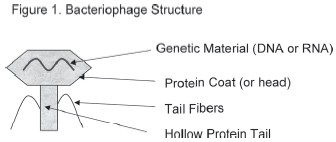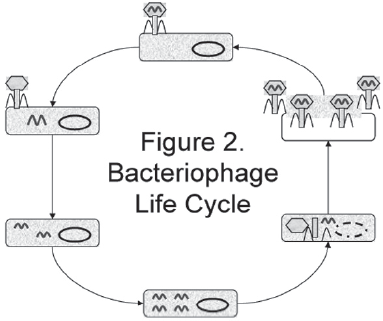



What are Bacteriophages?
By Frank T. Jones, Lisa Bielke and Jack Higgins, Center of Excellence for Poultry Science at the University of Arkansas's Avian Advice - Don’t let the big word (bacteriophage) scare you. Bacteriophages (sometimes called phages) are viruses that infect bacteria. The word “phage” means to eat, so the literal meaning of the word bacteriophage is “bacteria eater”. It may seem strange that creatures as small as bacteria could be infected with a virus, but bacteriophages are about 40 times smaller than bacteria and have apparently been around about as long as bacteria have. This article will provide an outline of how bacteriophages function and their possible benefits.| The Author | |
 Dr. Frank Jones Extension Section Leader |
|
Bacteriophage – Structure and Function
Bacteriophages have been compared to “space ships that are able to carry genetic material
between susceptible cells and then reproduce in those
cells” (Kutter, 1997). Bacteriophages are, in fact,
very simple organisms that consist of genetic material
(DNA or RNA) surrounded by a protein coat, a hollow
protein tail and tail fibers. The general structure of a
bacteriophage is shown in Fig. 1.
Figure 2 outlines the bacteriophage life cycle.
Bacteriophages cannot reproduce without a bacterial
cell. The bacteriophage particle attaches to a bacteria
and binds to the cell. The particle then injects genetic
material into the cell. The genetic material seizes
control of the cell causing it to make additional
bacteriophage genetic material.
In addition, the bacteriophage genetic material forces the cell
to make protein coats, hollow protein tails and tail fibers, which are then assembled into new
bacteriophage particles. Finally, when no more bacteriophage particles can be made, the cell breaks
open, releasing the new bacteriophage particles into the environment to repeat the process with other
bacterial cells. This process of infection, replication and release of new bacteriophage particles
continues until there are no more cells to infect. However, the description of the bacteriophage life
cycle may prompt questions. If this process happens with bacterial cells, what’s to keep it from
happening with plant, animal or human cells?
 The surface of each cell contains a unique blend of proteins, carbohydrates, fats and other
organic compounds. The organic compounds on the surface of bacterial cells allow bacteriophages
to recognize and attach only certain bacterial cells. If bacteriophages do not recognize the
characteristic blend of proteins, carbohydrates and fats, they will not attach to the cell. This means
that bacteriophages will not attach to cells unless they are bacteria. The organic compounds on
the surface of plant, animal and human cells are not recognized by bacteriophages and they do not
attach. In addition, the genetic material injected into cells by a bacteriophage is only capable of
acting on bacterial internal contents. Since the internal contents (that is, the structure and chemistry) of plant, animal and human cells is different from that of bacterial cells, bacteriophage genetic material cannot seize control of the cell. This means that even if a bacteriophage attached and
injected genetic material into a plant, animal or human cell, the material could not take over the
internal machinery of those cells (Kutter, 1997). Because of the specificity of bacteriophages, they
are considered safe and, indeed, bacteriophages have not been reported to infect plant, animal or
human cells.
The surface of each cell contains a unique blend of proteins, carbohydrates, fats and other
organic compounds. The organic compounds on the surface of bacterial cells allow bacteriophages
to recognize and attach only certain bacterial cells. If bacteriophages do not recognize the
characteristic blend of proteins, carbohydrates and fats, they will not attach to the cell. This means
that bacteriophages will not attach to cells unless they are bacteria. The organic compounds on
the surface of plant, animal and human cells are not recognized by bacteriophages and they do not
attach. In addition, the genetic material injected into cells by a bacteriophage is only capable of
acting on bacterial internal contents. Since the internal contents (that is, the structure and chemistry) of plant, animal and human cells is different from that of bacterial cells, bacteriophage genetic material cannot seize control of the cell. This means that even if a bacteriophage attached and
injected genetic material into a plant, animal or human cell, the material could not take over the
internal machinery of those cells (Kutter, 1997). Because of the specificity of bacteriophages, they
are considered safe and, indeed, bacteriophages have not been reported to infect plant, animal or
human cells.
In fact, bacteriophages tend to be very specific in the bacteria they infect. For instance, a
bacteriophage that infected an E. coli, would not infect a Salmonella. This specificity can be an
advantage and a disadvantage. Specificity could mean that specific pathogenic organisms are
knocked out, while beneficial organisms are left unharmed. However, when several organisms are responsible for a problem or
infection within an animal, bacteriophages would have to be directed at each organism. Bacteriophages may be beneficial in
treating human, animal and even plant diseases. In fact, it may surprise you to learn that bacteriophages (or phages) have been
used to treat bacterial diseases for over 80 years in Eastern Europe (Anonymous1, ND). Indeed, in the 1970s and 80s the Soviet
Union produced thousands of gallons of phage each month and every Soviet soldier carried a powder containing bacteriophage in
his emergency medical pack (Anonymous1, ND). A brief examination of the history of bacteriophages may be helpful here.

A Very Brief History of Bacteriophage
In 1896 a researcher reported that when the waters of the Ganges and Jumna Rivers in India were filtered to remove the
bacteria something in the waters was antibacterial. About 20 years later other researchers demonstrated that a virus was involved
and named the virus “bacteriophage” (Anonmymous3, ND). In view of the fact that at the time sulfa drugs and antibiotics were
not yet discovered, bacteriophages were explored as disease treatments. The first reported use of bacteriophage to treat a bacterial
disease came from France in 1921 (Anonymous2, ND). Bacteriophages were used to treat a variety of diseases. They were taken
orally, put on wounds, applied as aerosols, given as injections and used in eye drops. Success rates for bacteriophage therapy
were reported to be 75 to 100%, depending on the pathogen involved (Anonmyous3, ND, Kutter, 1997). Indeed, bacteriophage
products were produced by United States pharmaceutical companies and licensed for sale in the 1930s (Anonymous3, ND).
However, in the 1940s, new “miracle” drugs (antibiotics) became widely available and bacteriophage (or phage therapy) was
largely abandoned by the western world (Kutter, 1997). However, current difficulties with antibiotic resistant bacteria have
prompted researchers to re-examine bacteriophage.
Summary
Bacteriophages are viruses that infect only bacterial cells. Because of the specificity of bacteriophages, they are considered safe and have not been reported to infect plant, animal or human cells. Bacteriophages (or phages) have been used to treat bacterial diseases for over 80 years in Eastern Europe. Current difficulties with antibiotic resistant bacteria have prompted researchers to re-examine bacteriophage.
Literature Cited
Anonmyous1. no date. Bacteriophage or phage: A practical alternative to antibiotics.
http://isculpture.com/bacteriophage_or_phage.html visited April, 2005.
Anonymous2. no date. General information about bacteriophages.
http://www.phages.org/PhageInfo.html visited April, 2005.
Anonymous3. no date. Phage history. http://www.intralytix.com/history.html visited April, 2005.
Kutter, E. 1997. Phage therapy. http://www.evergreen.edu/phagetherapy/phagetherapy.html visited April, 2005.
Source: Avian Advice - Spring 2005 - Volume 7, Number 2









